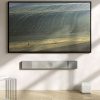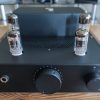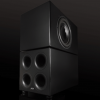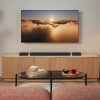Do find the digital output on the back of your DVD player before you connect any other cables to your equipment. It will be labeled “Optical” or “Coaxial” (your DVD player may have both or just one). An optical digital output uses a fiber-optic cable with a square plastic connector (Toslink) on each end. A coaxial digital output uses a standard shielded RCA cable that plugs into the female RCA jack labeled “Coaxial Digital”. Both sound the same. Use only one. An optical cable sometimes helps to avoid “ground loops” (see below). This single digital cable, optical or coaxial, carries all six channels of sound from a Dolby Digital 5.1 or dts movie soundtrack. It will also carry 2-channel digital PCM stereo (that’s what the data stream from a CD is called, should you use your DVD player to play your CDs). This digital cable does NOT carry video, only audio. Connect it to a digital audio input on the rear of your receiver.
Next, connect the video.
Decide at the outset if you want to route your video cables through the A/V receiver and then to the TV. Doing it this way has two advantages: convenience when you switch the receiver to watch a DVD, as well as the ability to see the on-screen menu for your AV receiver on your TV screen. If you route your video cables directly to the TV display, it’s initially easier to connect, but you won’t be able to see the receiver’s on-screen menu for setup purposes, and you’ll have to switch your TV display from the cable or satellite source to the “DVD Input”, which might be called “Video 1”. In well-designed AV receivers, routing the video through the receiver does not degrade picture quality so long as the component video inputs are “wideband” to 37 Megahertz (MHz) or greater, which will carry HDTV signals with no losses.
In any case, you must connect separate cables to your DVD player to carry the video signal to your TV display or AV/ receiver and then to your TV display. In most cases, your DVD player will have three different types of video outputs. If your TV and/or AV receiver handles Component Video, use those connections. This will deliver the highest image clarity possible from DVDs. There will be three RCA cables required, color-coded Red, Green and Blue and they are sometimes bundled together. If you have an older TV that lacks component video inputs, use the DVD player’s S-Video output (it’s a single cable with a multi-pin plug). It’s the next best. Finally, your TV may only have a Composite Video input, color-coded Yellow. That will yield a decent picture but not the maximum quality available from a DVD.
Your new HDTV and DVD player may also have HDMI or DVI connectors, single multi-pin cables that keep the video in its digital form, rather than converting it to analog, which is what Component Video connections carry. You can try the HDMI or DVI connectors but you may or may not see any difference in video quality over the component video connections. Use whichever connection yields the best picture on your TV display. Note, however, that some new receivers that offer HDMI switching may not process the HDMI signal correctly so that it will display on your TV.
Don’t turn the levels of your surround speakers up too high because you can’t “hear” them. You aren’t supposed to hear them in the conventional sense; that is, if they’re set at the correct levels, the surrounds should not call attention to themselves. Surround speakers are primarily used to deliver ambient effects for the on-screen action or to enhance the musical experience by adding the third dimension of space. Their purpose is to provide subtle envelopment of you, the listener/viewer, in the “sound field” or spatial experience of the place or scene occurring on-screen and to immerse you in the delayed secondary reflections of the space where the musical recording was made.
The surround isn’t intended to blast you with precise directional cues except for certain hard-mixed sounds that happen off-screen during gun battles, fights, chase sequences and the like. Much of the time, you may wonder if the surrounds are even on-until say, a rainstorm or outdoor sequence or perhaps a phone ringing off-screen suddenly reminds you of how much realism a surround system is capable of.
Note also that surrounds may not be used for long sequences during a movie. Low-budget independent feature films may have few or no surround effects at all. Big-budget action spectaculars, by contrast, will often make remarkable use of the surrounds to involve you in the action.
Don’t run your new HDTV (rear- or front-projection), plasma, or LCD panel at its brightest setting and shorten the life of the set (or the projector bulb). In the A/V business, that’s called “torching” the set. The brighter you run them, the shorter the longevity of the plasma panel or the DLP/LCD projector bulb. Besides, you’ll generally get much-improved highlight and shadow detail and smoother, more natural skin tones when you scale down the brightness and contrast. And that applies to older CRT (picture tube) sets as well.
Try this simple visual test to determine if you have your video image too bright or contrasty. Look at any white area on the screen during scenes from live TV or a movie. It could be the white shirt or blouse on an actor or TV host. Are you able to see detail within the white areas? If you can’t, then you are likely running the brightness too high, which washes out fine detail in bright areas. So lower the brightness and/or contrast. There’s a reason why control rooms for TV productions and telecasts are always dimly lit: it’s because video images on the monitors look best in a dim or darker room and the greatest range of colors and tones can be displayed.
Don’t just plunk down that subwoofer in the nearest corner and leave it there, making rash judgments on its performance before you’ve taken time to experiment with different subwoofer locations in the room. Subwoofer performance is so dependent on individual room dimensions and placement, as well as the relative position of chairs and couches, that you must experiment. A corner sub location will give you the greatest bass output at the risk of boomy or thumpy deep bass. You can always try a corner first; if the bass is too boomy, gradually reposition the sub away from the corner along one wall or the other. Try the “crawl” test, which you can read about here. It works quite well to determine the optimal placement for your subwoofer in any room.
Don’t turn up the subwoofer volume too high so you can “hear” it when you’ve first connected it. Start with the subwoofer turned all the way down while you play a selection of music (not a movie), then gradually increase the subwoofer volume until you detect the foundation of deep bass. Gradually increase the subwoofer level until it’s nicely in balance with the midrange and treble. If you’ve set it correctly, test it with a movie noted for its low-frequency content and you’ll likely find that the subwoofer level is ideal. You may still want to make slight adjustments of the subwoofer level using the A/V receiver’s remote control during movies or TV shows. Some directors or sound mixers get bass-obsessed and mix the bass levels too loud, which may be distracting and inhibit dialog clarity.
Look at the controls on the back panel of your subwoofer. There should be a control labeled “Crossover” and nearby it may have a switch labeled “Bypass”. In most home theater setups that use an A/V receiver, you will set the crossover control inside the receiver (a default setting of 80 Hz works very well in most installations) so the subwoofer’s internal crossover won’t be needed. Nor do you want to use it together with the crossover in the receiver. That’s called “cascading” crossovers and it’s not desirable. So if your subwoofer has a “Bypass,” then set it to that position. If the sub does not have a bypass setting, turn the crossover control to the highest frequency setting, usually around 150 Hz. That will effectively remove the subwoofer’s internal crossover from the circuit.
With all AV receivers and subwoofers, you’ll only need a single shielded RCA coaxial cable from the receiver’s Subwoofer Out connection (color-coded purple) to the subwoofers “line-level” or “low-level” female RCA input jack. Don’t use speaker cable to connect the subwoofer to an AV receiver. That would only be required for a receiver or amplifier that lacks a subwoofer output jack, e.g., an older stereo receiver or integrated stereo amplifier or a stereo “separates” installation. In those cases, you run two speaker cables from the stereo receiver’s left and right speaker outputs to the subwoofer’s left and right speaker inputs (they will be labeled “Speaker Level Inputs” or “High-Level Inputs”) and then from the subwoofer to your main speakers. For that installation, you would set the subwoofer’s own internal crossover. Try about 80 Hz as a crossover frequency.
Don’t get too fixated on perfectly “calibrating” the level of each channel so they are identical in a 5.1 or 7.1 system. Balancing the relative channel levels is an excellent starting point, but be prepared to make individual channel adjustments until you get a smooth, seamless blend of front channel music and effects, dialog clarity, and surround effects when they’re needed, and just the right amount of subwoofer bass. Note that dialog recording quality may vary quite a lot from one movie to the next, or even from scene to scene in the same movie. Some foreign or independent movies are poorly done, with dialog levels that vary constantly from scene to scene. The regional accents may make matters worse. So don’t be afraid to make center-channel level adjustments while you’re watching if you have trouble hearing the dialog. That’s what the center-channel level control is there for.
Do experiment with the location of your center-channel speaker and its sound quality before you drill holes or string wires. Human hearing is especially acute in the midrange where human voices (spoken and sung) reside, and it’s where we notice tiny discrepancies and tonal variations most. Moving the center channel speaker either below the TV or above it or even mounted to the wall may dramatically change the tonal balance of the speaker and greatly influence how well it blends with your front left and right speakers. So play a movie as you try different locations and listen to any tonal changes in the male or female voices of the actors. Pick the location that sounds best and works well with your setup. Some compromises are unavoidable, but a little experimentation always pays off in more natural-sounding dialog and better clarity.
Do set your center channel speaker and surround speakers to the “Small” setting. This will route the deep bass to the subwoofer and/or the main left and right front speakers (if they are set to “Large”) which is where the bass belongs. Setting a center to “Large” will inhibit dialog clarity and often add some tonal anomalies that you do not want. The vast majority of center channel and surround speakers do not have deep bass capabilities, nor are they intended to because soundtracks mix the bass to the “.1” subwoofer channel.
Do consider getting a test or setup DVD that will help you calibrate and adjust the surround sound levels as well as the video display. After all, you’ll likely spend thousands for the HDTV and home theater system. Spending from $20 to $40 for a test DVD and $40 for a Sound Level Meter will help you get the best out of your entire system. Here are several popular test discs, listed in ascending order of ease of use and complexity of test signals: Sound & Vision Magazine Home Theater Tune-Up (DVDI 0790); Avia Guide to Home Theater (Ovation Software); Digital Video Essentials (DVDI 0712). These test DVDs are mostly sold on-line. Try a Google search for outlets.
Don’t panic if you hear a loud deep bass hum when you first turn on your AV receiver, speakers and powered subwoofer together with your TV display. The hum is called a “ground loop” and it’s a very common side effect of linking audio, video, subwoofers and cable or satellite TV equipment together. There are specific ways to get rid of the hum and often it’s as simple as installing a ground-isolating transformer between the incoming cable-TV feed and your set-top box or TV display. Some cable TV system guys even know what a ground loop is and will install an isolation transformer for you. Occasionally just plugging the powered subwoofer into a different AC outlet in the room will eliminate the problem. In every case, however, all ground-loop hum problems are fixable.






























Dennis
October 14, 2012 at 10:05 am
Hello, I have had two surround systems, Sony and now Pioneer but have the same problem with each, they have both frozen regularly and you cannot do anything with them except disconnect the electric and start again, I have cable tv